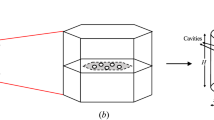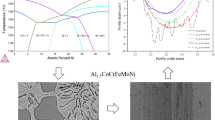Abstract
Voids are representative of the damage process in both creep and ductile fractures. Although the matrix/precipitate interface has been considered the preferential nucleation site for voids, the relationship between the atomic structure of this interface and the nucleation mechanism of a void has never been sufficiently investigated. In this study, the bcc Fe/V4C3 interface is selected as a model interface between a matrix and precipitate. The vacancy formation energy and intrinsic mechanical strength at this interface are investigated using a first-principles calculation because they should be related with the nucleation of creep and ductile voids, respectively. Within the considered interface, the Fe vacancy is found to be dominant. When the Baker–Nutting orientation relationship is satisfied at the interface, the calculated intrinsic mechanical strength of the interface is 23.8 GPa. However, when the geometric coherence at the interface is low as compared to that of the Baker–Nutting orientation relationship, it is found that the interfacial mechanical strength is significantly weakened. At each interface, it is found that the back-bond of the interface determined the interfacial strength because of the strongly bonded Fe–C on the interface. The nucleation mechanism of a void at the matrix/precipitate interface is discussed based on the present findings. It is suggested that local decohesion at the matrix/precipitate interface should be the origin of the nucleation of a ductile void.









Similar content being viewed by others
References
Kassner ME, Hayes TA (2003) Int J Plast 19:1715
Dobrzanski J (2004) J Mater Process Technol 157–158:297
Wahab AA, Kral MV (2005) Mater Sci Eng A 412:222
Wahab AA, Hutchinson CR, Kral MV (2006) Scr Mater 55:69
Kim KJ, Hong HU, Min KS, Nam SW (2004) Mater Sci Eng A 387–389:531
Sarwar M, Priestner R (1996) J Mater Sci 31:2091. doi:10.1007/BF00356631
Das SK, Chatterjee S, Tarafder S (2009) J Mater Sci 44:1094. doi:10.1007/s10853-008-3106-z
Erdogan M (2002) J Mater Sci 37:3623. doi:10.1023/A:1016548922555
Oh YJ, Lee BS, Kwon SC, Hong JH (1999) J Mater Sci 34:4751. doi:10.1023/A:1004630904296
Ogata S, Umeno Y, Kohyama M (2010) Model Simul Mater Sci Eng 17:013001
Mizuno M, Tanaka I, Adachi H (1993) Acta Mater 46:1637
Shishidou T, Lee JH, Zhao YJ, Freeman AJ (2003) J Appl Phys 93:6876
Arya A, Carter EA (2003) J Chem Phys 118:8982
Lee JH, Shishidou T, Zhao YJ, Freeman AJ, Olson GB (2005) Philos Mag 85:3683
Arya A, Carter EA (2004) Surf Sci 560:103
Tingaud D, Maugis P (2010) Comput Mater Sci 49:60
Cao J, Yong Q, Liu Q, Sun X (2007) J Mater Sci 42:10080. doi:10.1007/s10853-007-2000-4
Cabibo M, Fabrizi A, Merlin M, Garagnani GL (2008) J Mater Sci 43:6857. doi:10.1007/s10853-008-3000-8
Babu NK, Suresh MR, Sinha PP, Sarma DS (2006) J Mater Sci 41:2971. doi:10.1007/s10853-006-6718-1
Boniszewski T, Eaton NF (1969) Met Sci 3:103
Nakamura K, Ogata T (2011) J Soc Mater Sci 60:102
Emmons GH, Williams WS (1983) J Mater Sci 18:2589. doi:10.1007/BF00547575
Locci IE, Michal GM (1988) Metall Mater Trans A 20:237
Maropoulous S, Karagiannis S, Ridley N (2007) J Mater Sci 42:1309. doi:10.1007/s10853-006-1191-4
Tsuchida Y, Inoue T, Suzuki T (2004) Int J Press Vessel Pip 81:191
Baker RG, Nutting J (1959) Iron Steel Inst 64:1
Nishida T, Tanino M (1965) J Jpn Inst Met 29:728
Senior BA (1988) Mater Sci Eng A 103:263
Yamasaki S, Bhadeshia HKDH (2003) Mater Sci Technol 19:1335
Kresse G, Furthmüller J (1996) Phys Rev B 54:11169
Perdew JP, Burke K, Ernzerhof M (1996) Phys Rev Lett 77:3865
Perdew JP, Burke K, Ernzerhof M (1997) Phys Rev Lett 78:1396
Methfessel M, Paxton AT (1989) Phys Rev B 40:3616
Monkhorst HJ, Pack JD (1976) Phys Rev B 13:5188
Zhang J, Guyot F (1999) Phys Chem Min 26:206
James WJ, Straumanis ME (1960) J Electrochem Soc 107:69
Liu H, Zhu J, Liu Y, Lai Z (2008) Mater Lett 62:3084
Momma K, Izumi F (2008) J Appl Crystallogr 41:653
Ikuhara Y, Pirouz P (1996) Mater Sci Forum 207–209:121
Ikuhara Y, Sugawara Y, Tanaka I, Pirouz P (1997) Interface Sci 5:5
Ikuhara Y, Pirouz P (1993) Ultramicroscopy 52:421
Ikuhara Y, Pirouz P, Heuer AH, Yadavalli S, Flynn CP (1994) Philos Mag A 70:75
Sasaki T, Matsunaga K, Ohta H, Hosono H, Yamamoto T, Ikuhara Y (2003) Sci Technol Adv Mater 4:575
Sasaki T, Matsunaga K, Ohta H, Hosono H, Yamamoto T, Ikuhara Y (2004) Mater Trans 45:2137
Raj R, Ashby MF (1975) Acta Metall 23:653
Häglund J, Guillermet AF, Grimvall G, Körling M (1993) Phys Rev B 48:11685
Hartford J (2000) Phys Rev B 61:2221
Matsunaga K, Sasaki T, Shibata N, Mizoguchi T, Yamamoto T, Ikuhara Y (2006) Phys Rev B 74:125423
Peng P, Jin ZH, Yang R, Hu ZQ (2004) J Mater Sci 39:3957. doi:10.1023/B:JMSC.0000031477.24789.93
Voter AF, Montalenti F, Germann TC (2002) Ann Rev Mater Res 32:321
Author information
Authors and Affiliations
Corresponding author
Rights and permissions
About this article
Cite this article
Nakamura, K., Ohnuma, T. & Ogata, T. First-principles study of structure, vacancy formation, and strength of bcc Fe/V4C3 interface. J Mater Sci 46, 4206–4215 (2011). https://doi.org/10.1007/s10853-011-5426-7
Received:
Accepted:
Published:
Issue Date:
DOI: https://doi.org/10.1007/s10853-011-5426-7




